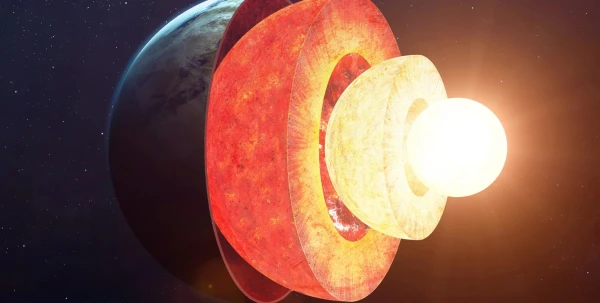
Researchers believe they have unraveled one of the planet's strangest mysteries — the presence of two dense giant masses inexplicably grouped above the planet's core, writes Focus.
In the 1980s, scientists discovered so-called large low shear wave velocity provinces (LLSVP) based on seismic data obtained during earthquakes. The seismic data revealed the presence of two large areas in the Earth's lower mantle: one beneath Africa and the other beneath the Pacific Ocean. Both extend upward from the core-mantle boundary, which is located about 2,900 kilometers below the Earth's surface, writes Science Alert.
Masses in the Earth's Interior
Through these areas, seismic waves propagate with a noticeable delay, indicating a difference in composition from the surrounding material. It was previously suggested that the mystery of these enigmatic masses could be explained by remnants of ancient tectonic plates, a cooling magmatic ocean, or fragments of a giant object called Theia, which once collided with Earth, forming the Moon.
Researchers have also linked the African mass to the weakening of the Earth's magnetic field beneath the Atlantic Ocean. Meanwhile, some scientists believe that these masses likely played a role in the formation of the planet's tectonic plates.
Scientists believe that unraveling the mystery of the enigmatic masses in the depths of our planet may be related to how our planet developed in the past, what is happening today, and what awaits Earth in the future.
Unraveling the Mysterious Masses in the Earth's Interior
In a new study, scientists used models capable of shedding light on the origin of the large low shear wave velocity provinces observed in the Earth's interior. Interestingly, the results of the new modeling do not match any of the expected versions of origin — it is likely that some material may have leaked from a leaking Earth's core when our planet was in its formative stage. Later, the material mixed with the mantle, forming those very mysterious masses.
According to geodynamicist Yesinori Miyazaki from Rutgers University, these masses are actually "not random oddities." In fact, they are likely fingerprints of the earliest history of our planet. As a result, scientists believe that understanding the nature of these masses may shed light on our understanding of how our planet formed and why it became habitable.
According to the researchers, the results of the new work indicate that these mysterious masses are very old and stable, which aligns with the magmatic ocean theory. According to this theory, our planet was a molten, viscous sphere covered by a magmatic ocean in the early stages of its history. As it cooled, this ocean differentiated, and heavier materials separated and sank.
It is worth noting that this idea also supports the existence of another type of structure — thin regions at the core-mantle boundary known as ultra-low velocity zones (ULVZ), which correlate with the edges of LLSVP, where seismic waves propagate an order of magnitude slower than through large low shear wave velocity provinces.
Magmatic Ocean Theory
If the magmatic ocean theory is correct, our planet should have neat, well-defined layers, like a cake, with a layer above the core-mantle boundary consisting of a significant amount of ferropericlase. However, seismic data indicate a much lower content of ferropericlase, while the very existence and chaotic configuration of LLSVP and ULVZ contradict this model.
According to Miyazaki, this contradiction became the starting point for their work with colleagues. If one starts with a magmatic ocean and conducts calculations, the result will not match what we see today on the modern planet — something is missing.
During the study, scientists conducted modeling to determine what is missing. The team mixed the main components of the planet and modeled their cooling, with and without material leaking from the planet's core. As a result, they managed to discover a secret ingredient.
Not all elements cool and crystallize at the same rate. The results of the modeling indicate that as the core cools and compresses under pressure, lighter components, such as magnesium oxide and silicon dioxide, crystallize faster than the iron in the composition. They rise up and are expelled through the core-mantle boundary into the magmatic ocean, where they dissolve.
Furthermore, this added material alters the chemical composition of the magma in such a way that it favors the formation of silicate-rich bridgmanite and seifertite, which then dominate the lower layer. At the same time, the content of ferropericlase remains low.
Even deep within the planet, where temperatures and pressures reach extreme values, these structures can be preserved for 4.5 billion years of our planet's existence, gradually merging through convection into the structures that scientists today detect using seismic data.
According to Miyazaki, all of this allows for a reconsideration of the magmatic ocean as a plausible explanation for the existence of the mysterious masses in the planet's interior. And if LLSVP and ULVZ played a role in the formation of tectonic plates, which are so crucial for life on Earth, it may shed light on how other planets evolved differently.















Leave a comment